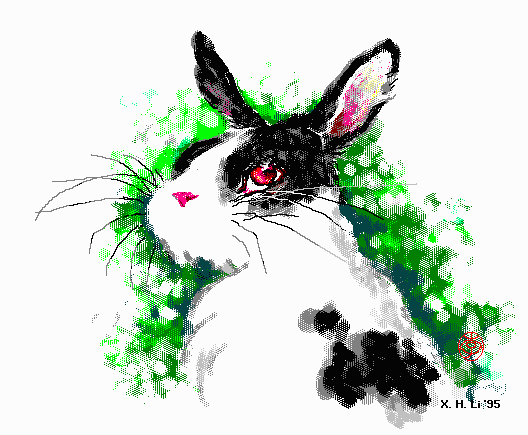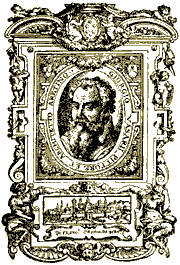TERZA PAGINA
La Pasqua e Suoi Simboli Opere di Italiani
La Rondine is published monthly by The Italian Club of St. Louis
President
Editor
Franco Giannotti Internet Edition

|
|
|
|
|
|
Recap of April Meeting
| Mille grazie to Prof. Michael Sherberg of
Washington University for his very informative presentation on the
history of Venetian Jews. The program was dedicated to the memory
of Paul Rava and was attended by his son John and his wife
Silvia. John Rava later sent a note thanking the Italian Club
for the kindness and attention shown to them, stating that his father would
have been proud and appreciative. The Rava Family has established
an endowment fund at Washington University in memory of Paul for the purpose
of furthering education and understanding of Italian Culture and History
through guest lecturers and student awards. Professor Sherberg’s presentation focused on the Jewish settlement in Venice. Interestingly, Jewish settlements were found in the Veneto region even in ancient times. Archeological remains and reliable testimony testify to the presence of Jews in Aquileia, Grado, and Concordia since the IV and V centuries. Jews from the East and transalpine countries were thefirst to settle there, but, after 1492, many Jews expelled from Spain and Portugal also arrived. Small communities were created in the mainland near Padua, Treviso, Bassano, and Conegliano. From there, Jews began to move to Venice where their residence was always precarious owing to the wavering policy of the Serenissima, which kept giving and withdrawing its permission to stay. Gradually, however, the number of Jews and the importance of the role they played in the life of the city kept growing. The Governor of the Republic then decided that the Jews had to live in only one area of the city. On 29 March 1516, a law decreed that that area was to be in the S. Girolamo parish and would be called "Ghetto Novo". Thus the first ghetto of Europe came into existence. Today it is a lively and thriving quarter, with its religious and administrative institutions, particularly two Synagogues, still open to service. Once again, our sincere thanks to Prof. Sherberg for a wonderful presentation! |
May Program:
| History and Art Treasures of Montecassino
|
|
Annual Scholarships
Awarded At April Meeting
We are pleased to announce the recipients of the scholarship awards sponsored by The Italian Club and by Southwest Bank: Emily Silverman and Kenneth Mitchell, who are students of Italian Studies at Washington University. These students were chosen by their professors for their exceptional scholastic abilities in the Italian language. During the award ceremony, both Emily and Kenneth read poems they had written in Italian, which we hope to publish in La Rondine sometime in the near future. We congratulate these students on their achievements and wish them all the best in their future pursuits! The Italian Club annually sponsors two $250 awards in honor of Mario Pertici and Frank LoPiccolo, both former presidents of the Italian Club. Southwest Bank sponsors a $500 award in honor of Fred Giacoma, also a former member of the Italian Club and vice-chairman of Southwest Bank. The scholarships are awarded annually to one or more deserving students to promote knowledge and study of Italian language and culture. |
| We are pleased to welcome the following new members to the Italian
Club:
Raymond Chiostri If you know of anyone else who is interested in becoming a member, please
contact Gene Mariani at 352-5484
and we will be happy to send them a membership application |
Now Accepting Nominations for
1998 Italian Heritage Award
| As many of you are aware, the Italian Club seeks to recognize and honor
individuals who have distinguished themselves through their services to
the Italian American community of the St. Louis region. Each year,
the Club presents its Italian Heritage Award to one or more deserving individuals,
typically during the month of June each year to coincide with our celebration
of the anniversary of the founding of the Italian Republic. Some
recent recipients include Fr. Lawrence Biondi (1997), John Vitale
(1996), Mario Pertici (1996), Gene Mariani (1996), Dante
Marconi (1995), and Thomas Collora (1995). We are currently seeking nominations for the 1998 Italian Heritage Award and would appreciate any suggestions you may have. Enclosed is a form that you may use to provide the Club’s Board of Directors with the information they will need to make a decision. All nominations will be kept confidential and we would appreciate receiving them by May 13, 1998. |
Panzanella
(Tuscan tomato and bread salad)
| This is a rustic, peasant-style salad that is becoming very popular
in restaurants around the United States. Panzanella is a traditional
salad found in many variations at trattorias throughout the Tuscan region.
The traditional recipe always includes chunks of slightly dried out bread
and cubed ripe tomatoes, along with cucumbers, onion, celery, vinegar,
and oil. Some versions include garlic, green olives, or tuna.
Others add chopped red, green, or yellow peppers. Use your imagination
and serve as a luncheon main dish, along with sausages and cheese, and
of course, a simple but fruity red wine. This will make you
want to pack a picnic basket and take off for a sunny hill with a beautiful
view!
4 cups slightly dried out bread, cubed Place the bread in a large bowl. Add the tomatoes, onion, cucumber,
celery, and basil, and toss gently to blend. If using, add the garlic
and green olives. Sprinkle with the vinegar and salt, and toss gently
to blend. Spoon the oil over the salad, sprinkle with freshly ground
black pepper, and toss once more. Set aside for 30 minutes to allow
the bread to absorb the dressing and the flavors to blend. Yields
6 to 8 servings. |
|
|
|
Una Volta
Eravamo
sulla collina di Bergamo, dentro
l'erba alta, io te i bimbi. Volgeva
su noi, tra pioggia e schiarita, la vaga
ruota dei raggi annerati: per l'aria
tremula si sfaceva
il paesaggio in delizia.
Eravamo alla punta della vita
(quella che più non torna, più non torna),
attraversati di luce, sospesi
in un mondo esitante, ombre gentili
assunte in un deliquescente eliso.
Sergio Solmi (Rieti 1899 - Milano 1981)
LA PASQUA E I SUOI SIMBOLI
La parola italiana pasqua deriva dal latino cristiano pascha,
dal greco páscha, e dall'ebraico pésah, passaggio
(la pasqua ebraica era stata istituita per commemorare l'uscita degli ebrei
dall'Egitto). La parola dovette poi essere  accostata
al latino pascua, pascoli. In inglese la parola easter pare
che derivi dal nome anglosassone Eastre, la dea teutonica della
primavera e della fertilità a cui era dedicato il mese di aprile.
La sua festa veniva celebrata il giorno dell'equinozio di primavera e questa
tradizione sopravvive ancora nel coniglio pasquale, simbolo di fertilità,
e nelle uova dipinte, i cui colori un tempo rappresentavano la luce brillante
del sole primaverile. Nell'ebraismo, la festa commemora la liberazione
dalla schiavitù dell'Egitto; nel cristianesimo la resurrezione di
Cristo. Come festa liturgica cattolica e di altre confessioni cristiane,
la Pasqua di Resurrezione cade nella domenica seguente al primo
plenilunio dopo il 21 marzo, l'equinozio di primavera. accostata
al latino pascua, pascoli. In inglese la parola easter pare
che derivi dal nome anglosassone Eastre, la dea teutonica della
primavera e della fertilità a cui era dedicato il mese di aprile.
La sua festa veniva celebrata il giorno dell'equinozio di primavera e questa
tradizione sopravvive ancora nel coniglio pasquale, simbolo di fertilità,
e nelle uova dipinte, i cui colori un tempo rappresentavano la luce brillante
del sole primaverile. Nell'ebraismo, la festa commemora la liberazione
dalla schiavitù dell'Egitto; nel cristianesimo la resurrezione di
Cristo. Come festa liturgica cattolica e di altre confessioni cristiane,
la Pasqua di Resurrezione cade nella domenica seguente al primo
plenilunio dopo il 21 marzo, l'equinozio di primavera. |
OPERE DI ITALIANI AL MUSEO DI ST. LOUIS
13. Giorgio Vasari. Giuditta e Oloferne. (Olio, circa 1554)
 Benché
in vita fosse famoso come pittore e architetto (lavorò per Giulio
III, e realizzò la ristrutturazione del centro storico di Firenze
e il Palazzo degli Uffizi per Cosimo I de' Medici), il Vasari (Arezzo 1511-Firenze
1574) è oggi famoso soprattutto per Le vite de' più eccellenti
pittori, scultori et architettori (1568), prima opera fondamentale
di critica artistica che abbraccia il periodo che va da Cimabue al XVI
secolo. Come pittore il Vasari, insieme a Pontormo, Bronzino, Rosso Fiorentino,
Parmigianino, e Tintoretto, è uno dei principali esponenti del Manierismo.
Storicamente questo termine indica le manifestazioni artistiche sviluppatesi
inizialmente a Roma e a Firenze a partire dalla seconda metà del
XVI secolo. Considerando i grandi del Rinascimento come modelli
classici da riproporre all'imitazione e alla rielaborazione, i manieristi
pervennero in ogni campo a forme molto eleganti e raffinate, frutto di
una formale e intellettualistica applicazione di certi moduli, preparando,
in un certo senso, il barocco. Nel quadro del museo di St. Louis, il Manierismo
è reso evidente dalla composizione stessa oltre che da altri elementi
pittorici. I tre personaggi Giuditta, Abra e Oloferne, sono racchiusi in
uno spazio molto ristretto: Giuditta è dipinta in una posizione
che mette in rilievo i muscoli poderosi della schiena contorta nello sforzo
di decapitare Oloferne addormentato, del quale pure si vede la schiena
possente; mentre Abra, pericolosamante vicina alla sciabola sguainata,
corre il rischio di essere decapitata insieme a Oloferne. Il Vasari, per
dimostrare la sua abilità nel creare un disegno, o composizione,
ha sacrificato la fedeltà alla natura, concetto prevalente
durante il Rinascimento, all'effetto drammatico. Benché
in vita fosse famoso come pittore e architetto (lavorò per Giulio
III, e realizzò la ristrutturazione del centro storico di Firenze
e il Palazzo degli Uffizi per Cosimo I de' Medici), il Vasari (Arezzo 1511-Firenze
1574) è oggi famoso soprattutto per Le vite de' più eccellenti
pittori, scultori et architettori (1568), prima opera fondamentale
di critica artistica che abbraccia il periodo che va da Cimabue al XVI
secolo. Come pittore il Vasari, insieme a Pontormo, Bronzino, Rosso Fiorentino,
Parmigianino, e Tintoretto, è uno dei principali esponenti del Manierismo.
Storicamente questo termine indica le manifestazioni artistiche sviluppatesi
inizialmente a Roma e a Firenze a partire dalla seconda metà del
XVI secolo. Considerando i grandi del Rinascimento come modelli
classici da riproporre all'imitazione e alla rielaborazione, i manieristi
pervennero in ogni campo a forme molto eleganti e raffinate, frutto di
una formale e intellettualistica applicazione di certi moduli, preparando,
in un certo senso, il barocco. Nel quadro del museo di St. Louis, il Manierismo
è reso evidente dalla composizione stessa oltre che da altri elementi
pittorici. I tre personaggi Giuditta, Abra e Oloferne, sono racchiusi in
uno spazio molto ristretto: Giuditta è dipinta in una posizione
che mette in rilievo i muscoli poderosi della schiena contorta nello sforzo
di decapitare Oloferne addormentato, del quale pure si vede la schiena
possente; mentre Abra, pericolosamante vicina alla sciabola sguainata,
corre il rischio di essere decapitata insieme a Oloferne. Il Vasari, per
dimostrare la sua abilità nel creare un disegno, o composizione,
ha sacrificato la fedeltà alla natura, concetto prevalente
durante il Rinascimento, all'effetto drammatico. |